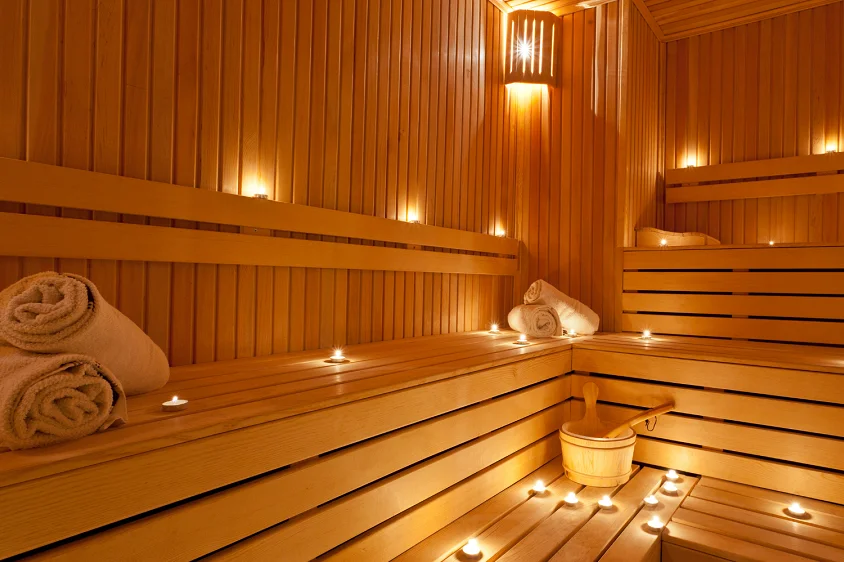Sauna Therapy for Improved Sleep Quality
- Updated on: Dec 26, 2023
- 10 min Read
- Published on Dec 7, 2023

Imagine yourself in a warm embrace; not just any hug but one from an age-old tradition—sauna therapy. The gentle hum of heat wrapping around your body as stress melts away like ice under the summer sun.
This isn’t some fairy tale remedy though—it’s backed by science! Sauna sessions can work wonders for relaxation and sleep patterns. And nope—you don’t need to choose between traditional or infrared saunas because we’ll dive into both!
Let’s dive into this sizzling subject together – no pun spared! We’ll examine how using a sauna influences sleep-regulating hormones and share tips for creating a calming sauna space. So, strap in and get ready!

The Growing Interest in Sauna Therapy for Sleep Improvement
More people are turning to sauna therapy as a natural solution for better sleep. This trend is fueled by the growing understanding of the connection between heat exposure and restful slumber. You can explore your sauna options from Komowa which has a premium variety of different types of saunas.
Saunas have been part of wellness routines around the world, from Finland’s centuries-old tradition to Japan’s onsen culture. However, their role in improving sleep quality has gained special attention recently. A key factor behind this surge is our increasing knowledge about how saunas can help balance body temperature and stress hormones – two elements closely tied to good sleep.
The Appeal of Natural Sleep Solutions
In an era where many are wary of pharmaceutical solutions with potential side effects, natural remedies like sauna therapy offer an attractive alternative. They let you harness your body’s innate mechanisms – such as its response to heat – without relying on external substances.
Besides promoting relaxation and reducing muscle tension, using a sauna before bed can also induce deeper stages of sleep thanks to the post-sauna cooling process which mimics our bodies’ pre-slumber cooldown phase.
- This makes falling asleep easier,
- Promotes uninterrupted nights,
- And even enhances dream activity according to some anecdotal reports.
The Science Behind Sauna Therapy and Sleep Quality
A good night’s sleep is essential for our well-being, and sauna therapy may be the key to achieving it. But what if we told you there’s a way to boost your sleep quality naturally? Enter sauna therapy.
The Role of Body Temperature and Relaxation
Did you know your body temperature plays an integral part in getting a restful slumber? That’s right. When the body starts cooling down, it signals the brain that it’s time to get some shut-eye. A session in the sauna raises your core temperature, but when you step out, this sudden drop initiates relaxation.
This study from the National Sleep Foundation supports how changes in body temperature can influence sleep patterns. It suggests that post-sauna cool-down could be just what you need for deeper snooze sessions.
Cortisol and Melatonin Levels in Sauna Use
Saunas don’t just help with physical relaxation; they play a role in hormonal levels too. The heat stress experienced during a sauna session prompts the adrenal glands to release cortisol – often referred to as the ‘stress hormone’. This might sound alarming but bear with us.
In response to dropping cortisol levels after leaving the sauna, melatonin (our key ‘sleep hormone’) production ramps up helping prepare us for better Zzzs. This fascinating interplay between these hormones can contribute towards improving not only sleep quality but also its duration.
So, whether you’re battling sleep issues or simply looking to improve your nightly rest, sauna therapy might just be the missing piece in your bedtime routine. It is advisable to consult with a medical professional before beginning any new health regimen, even though saunas are typically secure for most individuals.
Traditional vs. Infrared Saunas for Sleep Quality
When it comes to sauna therapy, you might wonder: which is better for sleep quality – traditional or infrared saunas? Well, both have their unique perks and differences.
The Traditional Sauna Experience
A traditional sauna, often known as a Finnish sauna, uses heat and humidity to induce sweat. The hot environment promotes relaxation by triggering the release of endorphins in your body. These ‘feel-good’ chemicals can help set up the perfect prelude to a restful night’s sleep.
But there’s more. Increased sweating helps detoxify your body, which may indirectly contribute to improved sleep patterns.
Infrared Saunas – A Modern Twist on an Old Practice
Unlike traditional saunas which heat the surrounding air, infrared saunas use light waves that penetrate deeply into the skin to directly warm your body at lower temperatures. This method heats your body directly at lower temperatures than traditional saunas but still provides similar benefits such as muscle relaxation and stress relief—key components of good-quality slumber.
Fascinatingly enough, some studies suggest that this type of direct heat application could stimulate serotonin production—a hormone responsible for mood regulation and crucial for sound sleep.
Making Your Choice
Selecting between these two types depends largely on personal preference. You’ll want something that suits not only your comfort level but also aligns with how much time you’re willing to invest in sauna therapy. Remember, establishing a routine you can stick to and enjoy is essential.
Drink plenty of water before and after any sauna session – your body will appreciate it. And don’t forget: consistency is key when using saunas for improved sleep quality.
Timing, Duration, and Frequency of Sauna Sessions for Optimal Sleep Benefits
Understanding the right timing, duration, and frequency of sauna sessions can make a world of difference in your sleep quality. Let’s look at these three key elements more closely.
The Importance of Timing
One’s corporeal form has a timepiece that resides within, termed the circadian cadence, which affects slumbering habits. Using a sauna shortly before bedtime may aid in inducing better sleep. This is because the heat from the sauna mimics the natural drop in body temperature that happens before you fall asleep.
Finding Your Ideal Duration
The length of time individuals spend in a sauna can vary greatly due to elements such as individual comfort and health issues. However, studies have shown benefits with sessions lasting between 15 to 30 minutes. Too long could lead to dehydration or overheating so it’s crucial not only to listen to your body but also to keep hydration levels high during each session.
Determining Frequency
In terms of how often one should use a sauna for improved sleep quality, research suggests regularity matters more than quantity. The Sleep Foundation reports that frequent short sessions are typically better than infrequent longer ones when aiming for optimal sleep benefits.
- Maintain Consistency: Regularly scheduled saunas give consistency aiding relaxation efforts leading up to bedtime routines.
- Balanced Approach: Overdoing any good thing might tip balance scales unfavorably causing adverse effects like increased heart rate disrupting sound slumber later on the night.
Creating a Relaxing Sauna Environment for Better Sleep
Saunas are more than just places to sweat. They can be sanctuaries of relaxation, designed with the sole purpose of enhancing your sleep quality. So how do you transform this heat-filled room into a restful haven?
The first step is understanding the importance of ambiance. The right lighting and soothing sounds play pivotal roles in creating an atmosphere conducive to relaxation.
Ambiance Is Key
To start off, consider dimming lights or using colored LED bulbs that mimic sunset hues – they give off soft, warm tones that encourage your body’s natural sleep rhythm. Additionally, adding essential oils like lavender or chamomile not only gives pleasant scents but also promotes tranquility. Nature sounds have been scientifically proven to reduce stress levels and induce sleep quicker too – so playing recordings of rainfalls or ocean waves can be incredibly beneficial.
Finding Comfort
Your physical comfort inside the sauna matters as well. Investing in ergonomic seats helps maintain good posture without straining your muscles – important if you want full-body relaxation leading up to bedtime.
You might think the temperature isn’t adjustable since saunas are supposed to be hot. However, controlling it within tolerable limits ensures maximum benefits from each session while avoiding overheating risks. According to Harvard Health, temperatures between 150-175°F (65-75°C) are ideal.
Post-Sauna Rituals
Your sauna session doesn’t end when you step out. It’s beneficial to continue your relaxation with a cool shower or bath – this helps lower body temperature, further signaling it’s time for sleep. Sipping on chamomile tea could be another soothing post-sauna ritual.
When you weave these elements into your sauna design, it’ll transform the space. You’ll get a refreshing experience that leaves you rejuvenated every time.
Sauna Therapy as a Natural Solution for Insomnia and Sleep Apnea

Slumbering troubles such as insomnia and sleep apnea are all too common, leaving one feeling drained. But, sauna therapy could be the answer to your restless nights.
Sauna therapy has been found to promote the production of melatonin, a hormone responsible for regulating our sleep-wake cycle, which may help with insomnia and sleep apnea. A study published in PubMed showed an increase in melatonin levels following regular sauna use.
The Effect on Insomnia
A good night’s rest might seem like a dream if you suffer from insomnia. Enter sauna therapy: it helps relax your body and mind, preparing you for slumber. Studies have found that individuals who regularly used saunas experienced fewer instances of disturbed sleep or waking up during the night than those who didn’t take part in this heated relaxation practice (Sleep Foundation). So, say goodbye to counting sheep.
Tackling Sleep Apnea with Sauna Therapy
If you’re dealing with obstructive sleep apnea (OSA), where breathing temporarily stops while sleeping due to blocked airways, consider incorporating sauna sessions into your routine. The heat helps improve circulation which may reduce snoring caused by OSA according to research shared by SAGE Journals. It’s like getting a good night’s sleep without the orchestra of snores.
But remember, sauna therapy is not a cure-all. It can be part of an effective treatment plan when combined with other lifestyle changes and medical treatments advised by your healthcare provider.
A Note on Safety
Before you start sweating it out in the sauna for better sleep, make sure to stay hydrated and avoid overexposure. Sauna use should always align with your individual health needs – so don’t forget to consult your doctor before starting this or any new wellness regimen.
Regular Sauna Use for Reduced Muscle Tension and Stress
If you’ve ever soaked in the heat of a sauna, you know that it’s more than just sweating out toxins. It’s about letting go of the day’s stress and allowing your muscles to relax. But did you know this relaxation can lead to better sleep?
Harvard Health Publishing notes that saunas can stimulate the release of endorphins, our body’s natural painkillers, which also induce feelings of relaxation and contentment. This ‘endorphin rush’ helps reduce muscle tension, making it easier for your body to wind down at night.
The Impact on Stress Levels
Stress is often a major culprit behind poor sleep quality. As many as 77% of people experience physical symptoms caused by stress according to American Psychological Association. So how does sitting in a hot room help? Sauna use has been shown to reduce cortisol levels, a hormone associated with stress. Lowering cortisol levels before bedtime could make it easier for us to fall asleep and stay asleep.
Soothing Muscles for Sleep Readiness
In addition to reducing stress hormones, saunas promote blood flow throughout our bodies due to their warm temperatures causing vasodilation (widening) in our blood vessels. Increased circulation delivers more oxygen-rich blood into tight or sore muscles helping them unwind.
This physiological response paired with a perceived reduction in joint pain can contribute to improved sleep quality. A study published in the Journal of Physiological Anthropology and Applied Human Science found that participants who used a sauna before bed reported better sleep. Here’s the secret – keeping stress and tension at bay can lead to more restful nights.
Safety Guidelines and Hydration During Sauna Sessions
For sauna therapy, safety should be paramount. Staying hydrated is essential to ensure a safe sauna session, as fluids are lost through sweat and can lead to dehydration if not replaced.
Drinking water is vital because as you sweat in the sauna, your body loses fluids. So replacing these lost fluids can help prevent dehydration which could lead to dizziness or even fainting. You’ll need more than just a sip; aim for at least two full glasses of water before you start your session.
The Dos and Don’ts Inside a Sauna
Navigating through a safe sauna experience isn’t complicated but there are certain guidelines worth noting down. First off: don’t stay too long. Experts suggest starting out with sessions lasting 15-20 minutes until you get accustomed to the heat.
Additionally, alcohol consumption before entering a sauna is not advised due to its dehydrating effects that intensify within high temperatures. Lastly, remember to cool down gradually afterward – rushing into colder environments might shock your system.
Paying Attention To Your Body’s Signals
Your body knows best when it needs rest so listen closely when inside the hot room. Feeling dizzy or nauseous? It’s time to step outside and give yourself some fresh air while hydrating with plenty of liquids.
In essence: practicing proper hydration techniques along with following these simple yet crucial safety measures will ensure an enjoyable sauna experience. Remember this advice every time – whether it’s for improving sleep quality or just relaxation – make sure comfort and safety always come first.
Health Considerations Before Starting Sauna Therapy
Before beginning sauna therapy to better your sleep, it is essential that you assess your overall health. Not everyone can safely use a sauna. But don’t worry. With some caution and the right guidance, many people can benefit from this soothing practice.
People with heart conditions should be particularly careful when considering sauna therapy. The heat of a sauna increases blood flow and could put undue strain on an already stressed cardiovascular system according to Mayo Clinic. If you have high blood pressure or other heart-related issues, consult with your healthcare provider before starting any new therapies.
Pregnant women also need to tread carefully as saunas may cause overheating which is not safe for the developing baby as per American Pregnancy Association guidelines. Remember, if in doubt always ask your doctor.
The Importance of Hydration During Sauna Sessions
Sweating in a hot environment like a sauna means that we lose more water than usual from our bodies – so hydration is key. Make sure you drink plenty of fluids before entering the sauna and replenish after every session too. Neglecting hydration can lead to dehydration symptoms such as headaches or dizziness during or after your time in the steamy haven.
Finding Your Comfort Zone: Individual Tolerance Levels Matter
No two individuals are alike – especially when it comes to heat tolerance. Start with shorter sessions and lower temperatures, gradually increasing as you become more comfortable. This slow-start approach helps prevent any sudden shocks to the system.
Though sauna therapy can be beneficial, it is important to note that it may not be suitable for everyone. Always consult your healthcare provider before starting new therapies – because when it comes to health, safety always comes first.
Final Thoughts
What a journey through the heat, right? Sauna therapy for improved sleep quality isn’t just an idea—it’s science-backed. Saunas work their magic by altering body temperature and tweaking hormone levels. Both traditional and infrared saunas can lead to better Zzzs, with their unique benefits.
The timing of your sauna sessions matters too. And don’t forget to make your sauna space as relaxing as possible—think dim lights and soft music. This age-old tradition could be your solution if you struggle with insomnia or sleep apnea. Regular use also helps ease muscle tension and stress, giving way to peaceful nights.
Remember though—hydration is key! Also, some health conditions might need a doctor’s green light before you start sweating it out for better sleep. So get ready for restful nights filled with sweet dreams!











